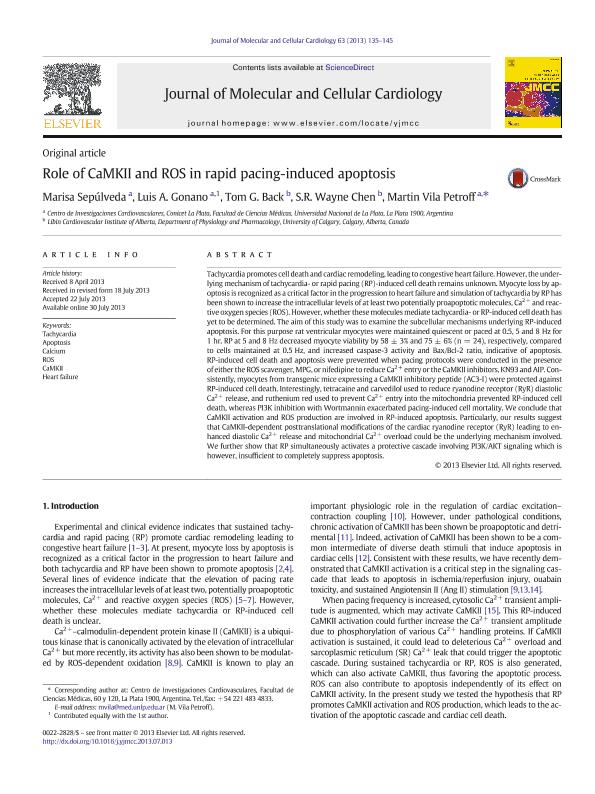Artículo
Role of CaMKII and ROS in rapid pacing-induced apoptosis
Sepúlveda, Marisa Noemí ; Gonano, Luis Alberto
; Gonano, Luis Alberto ; Back, Tom G.; Chen, S. R. Wayne; Vila Petroff, Martin Gerarde
; Back, Tom G.; Chen, S. R. Wayne; Vila Petroff, Martin Gerarde
 ; Gonano, Luis Alberto
; Gonano, Luis Alberto ; Back, Tom G.; Chen, S. R. Wayne; Vila Petroff, Martin Gerarde
; Back, Tom G.; Chen, S. R. Wayne; Vila Petroff, Martin Gerarde
Fecha de publicación:
10/2013
Editorial:
Elsevier
Revista:
Journal Of Molecular And Cellular Cardiology
ISSN:
0022-2828
Idioma:
Inglés
Tipo de recurso:
Artículo publicado
Clasificación temática:
Resumen
Tachycardia promotes cell death and cardiac remodeling, leading to congestive heart failure. However, the underlying mechanism of tachycardia- or rapid pacing (RP)-induced cell death remains unknown. Myocyte loss by apoptosis is recognized as a critical factor in the progression to heart failure and simulation of tachycardia by RP has been shown to increase the intracellular levels of at least two potentially proapoptotic molecules, Ca2 + and reactive oxygen species (ROS). However, whether these molecules mediate tachycardia- or RP-induced cell death has yet to be determined. The aim of this study was to examine the subcellular mechanisms underlying RP-induced apoptosis. For this purpose rat ventricular myocytes were maintained quiescent or paced at 0.5, 5 and 8 Hz for 1 hr. RP at 5 and 8 Hz decreased myocyte viability by 58 ± 3% and 75 ± 6% (n = 24), respectively, compared to cells maintained at 0.5 Hz, and increased caspase-3 activity and Bax/Bcl-2 ratio, indicative of apoptosis. RP-induced cell death and apoptosis were prevented when pacing protocols were conducted in the presence of either the ROS scavenger, MPG, or nifedipine to reduce Ca2 + entry or the CaMKII inhibitors, KN93 and AIP. Consistently, myocytes from transgenic mice expressing a CaMKII inhibitory peptide (AC3-I) were protected against RP-induced cell death. Interestingly, tetracaine and carvedilol used to reduce ryanodine receptor (RyR) diastolic Ca2 + release, and ruthenium red used to prevent Ca2 + entry into the mitochondria prevented RP-induced cell death, whereas PI3K inhibition with Wortmannin exacerbated pacing-induced cell mortality. We conclude that CaMKII activation and ROS production are involved in RP-induced apoptosis. Particularly, our results suggest that CaMKII-dependent posttranslational modifications of the cardiac ryanodine receptor (RyR) leading to enhanced diastolic Ca2 + release and mitochondrial Ca2 + overload could be the underlying mechanism involved. We further show that RP simultaneously activates a protective cascade involving PI3K/AKT signaling which is however, insufficient to completely suppress apoptosis.
Palabras clave:
Tachycardia
,
Apoptosis
,
Calcium
,
Ros
,
Camkii
,
Heart Failure
Archivos asociados
Licencia
Identificadores
Colecciones
Articulos(CIC)
Articulos de CENTRO DE INVEST.CARDIOVASCULARES (I)
Articulos de CENTRO DE INVEST.CARDIOVASCULARES (I)
Citación
Sepúlveda, Marisa Noemí; Gonano, Luis Alberto; Back, Tom G.; Chen, S. R. Wayne; Vila Petroff, Martin Gerarde; Role of CaMKII and ROS in rapid pacing-induced apoptosis; Elsevier; Journal Of Molecular And Cellular Cardiology; 63; 10-2013; 135-145
Compartir
Altmétricas



